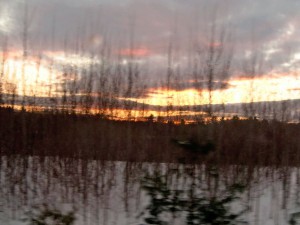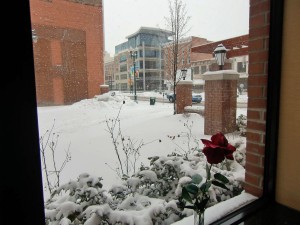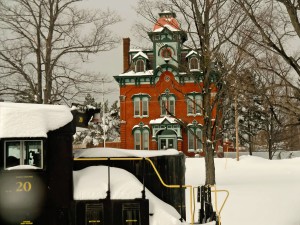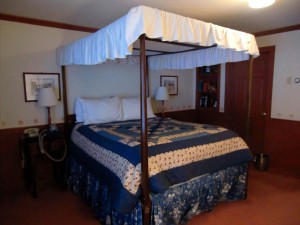IN SEARCH OF SNOW – SNOW AND MORE SNOW
IN SEARCH OF SNOW
This is the ninth in a series of articles about traveling by rail in search of snow
SNOW AND MORE SNOW
By Charles N. Stevens
Photos by Dolores Seidman
In Schenectady, New York we wake up to snow sifting down out of a gray sky, the scraping of plows clearing the streets the only sound. At breakfast time large flakes fall like goose feathers being shaken out of a thousand pillows. The flakes shift in the currents, drifting first one way then another, placing soft white caps on red fire hydrants, a mail box, trash bins and parking meters. Cars carrying their white burdens slosh through the slushy streets as the plows can’t keep up with the accumulating snow. A man wearing a black jacket walks by, so much snow plastered against his front that he looks like a walking snowman.
At the intersection outside the hotel, a city worker labors with a small Bobcat plow and a shovel, trying to make it passable. Another truck dumps rock salt on the roads. All schools are closed, probably making the kids happy but the mothers irritated. The temperature is 23 degrees. I walk outside, savoring the snowfall first hand, crunching through the thick white blanket, relishing the sensation of the delicate flakes on my face and the biting chill of the air.
Back up in our room again, I look down on the parking lot where tire tracks and footprints mark the fresh fallen carpet. So much snow has accumulated on the headlights of a car that the light barely shows through. I watch the erratic drift of snow, and streamers of it blowing off the roof like white smoke, impressed by the silence of it all.
After breakfast we jam ourselves and our baggage into a yellow school bus for the short ride to the railroad station. We have to wait a long time before the bright headlight of our train, the Adirondack, appears out of the mist. The station platform is cold, wet and windy, and we are anxious to enter the warmth of the train. The snow has stopped, but all the trees and shrubs are laced with it. As our train rushes by the trees, the breeze of our passing blows the cottony fluff from them, scattering them everywhere. Our locomotive whips up the powdery snow as we hurtle down the tracks, leaving a trail of swirling white dust. Farmland on both sides of is buried in a thick mattress of white.
By two in the afternoon we pause at Fort Edward where we pass an old deteriorating freight house and freight yard where box cars are topped with snow and hung with icicles. We are taken with the winter scenery, so unlike southern California where we live and more like the calendar pictures depicting December or January. But it’s March, and it still looks like midwinter.
We pass by Lake Champlain covered in whiteness and we wonder whether it would support a man walking across it. Rows of cabins line its edge and boats are in racks for winter storage. So much snow and ice stirred up by the train is blowing past our windows that it is sticking to the glass, making it is difficult to see out of them. We take a siding for another train to pass. It whines by, then we are on our way again, the melody of our train whistle echoing out over the frozen landscape. A high gray overcast dominates the sky, but a line of clear blue is beginning in the west.
Other parts of Lake Champlain are still unfrozen with plates of ice floating in it. A shaft of late afternoon sunlight slants across the ice. Hundreds of ducks, startled by our train, swim frantically away from the edge of the lake, rippling and splashing the icy water. Another sun beam catches snow-laden pines, sagging under the burden like frozen sculpture. The spiky bare branches of fruit trees in an orchard wait patiently for spring.
Platzburg is a snow-filled town, so quaint with its old architecture and Christmas card look that I would like to visit it some day.
At Rouse’s Point, New York we detrain in the dark, stepping out gingerly on the packed snow, hoping not to slip. We look back at our train in amazement as it is totally encased in snow and ice, a most unusual sight in the dim light of the station. We board a bus that will take us on a two-hour ride to Stowe, Vermont where we will stay at the Green Mountain Inn. We travel through the night, mostly through dark open country with lights few and far between, arriving at Stowe after nine o’clock.
Dolores and I are assigned a room near the back of the inn where we have to crunch through foot-packed snow and scattered salt, the temperature only eighteen degrees. We pass near the frozen pool where snow has drifted completely over the lounge chairs, forming smooth white parabolas of some beauty. We are told that yesterday’s snow storm was the third largest in the history of Stowe and that many of the maids could not get in to town to make up the rooms, the management having to hustle to get them ready for us. We finally arrive at our room through a maze of outside walkways, hallways and stairs. A huge four-poster bed dominates our small room, the mattress so high that we have a difficult time struggling onto it. Exhausted, all we want to do is sleep.

As we pass frozen Lake Champlain, the sky finally begins to clear.

The snow piles up outside the window of our hotel in Schenectady.

Even a locomotive looks beautiful draped with fresh-fallen snow.

When we at last arrive at the Green Mountain Inn in Stowe, Vermont, this four-poster bed looks good to us
.
MONTEREY PARK AUTHOR PUBLISHES 3RD BOOK ABOUT HIS EXPERIENCES IN WORLD WAR II- BACK FROM COMBAT
Charles “Norm” Stevens, a 40 year resident of Monterey Park and World War II Veteran has recently published the 3rd in his series about his experiences in WW II, Back from Combat: A WWII Bombardier Faces His Military Future. This book details the time from when he returned from combat in England where he flew 34 missions over Germany and France until the end of the war. Faced with large numbers of returning combat vets, and not knowing how long the war would continue, the military had to plan for their future. His options were whether to return to combat, become an instructor in the U.S., or receive new training that he would use in the Pacific. The book concludes with the end of the war with an Afterward that includes an update on the B-l7’s still flying in the U.S., as well as present day accounts pertaining to the war.
Stevens is the author of two previous books about his experiences:
An Innocent at Polebrook: A Memoir of an 8th Air Force Bombardier (Story of his 34 bombing missions from his base at Polebrook, England over Germany and France)
The Innocent Cadet: Becoming A World War II Bombardier (A prequel to the first, telling of his training in the U.S. before going overseas into combat.)
He is known to the readers of The Citizen’s Voice as the author of Travel Log Articles including “From Paris to Normandy on the Seine”, “Exploring New York” and “In Search of Snow.” He is retired, having taught for 32 years, primarily in the Montebello Unified School District.
Those interested in purchasing an autographed copy of any of his books, may contact the author at 323-721-8230 or Normstevens24@gmail.com.



